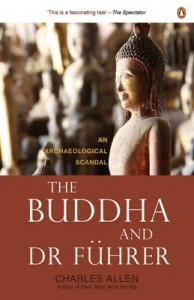
I have often been intrigued by how the excavations are done? How are the records of various finds reconciled? And how the archeologists and historians work out the history especially from the pre-historic times. I picked up this book The Buddha and Dr. Fuhrer to understand the dynamics of tracing history through archeological pieces of evidence.
The book The Buddha and Dr. Fuhrer take you through the excavations of stupas spread across the Terai region on the border of India and Nepal towards the end of the late 19th century. A stupa that lies in the estate that belonged to an English family is discovered by accident. And then carefully excavated by the owner of the estate. All the finds of the excavation that included stone caskets with bone relics and a whole lot of items in precious metals, stones, and gems are recorded. And shared with the archeological authorities of that time. One of the caskets has an inscription on it that went around the world for an interpretation. And is commonly believed to say that the bone relics belong to the Buddha himself. A part of the relics received by his kinsmen when they were divided into 8 parts.
What is happening parallelly is a series of archeologists wanting to find the exact location of Kapilavastu. The city where Buddha grew up based on the accounts of two Chinese travelers who traveled across India some two centuries apart from each other. Both of them recorded a visit to Kapilavastu. And described the stupas and the city there. But the accounts are a bit different. And do not lead to the same place. Since there was a huge time gap between their travels, things could have changed. And so could have their writings. Or there can always be a human error in the recording by one of them. Or some details could have been lost in translation.
Nonetheless, a few archeologists who wanted to lay claim to the discovery of the city indulged in all kinds of activities like traveling between Nepal and India in Terai region. Which required a lot of permissions from Nepalese durbar during those days. Excavating mounds that were spread across the area, finding Asoka pillars wherever they could, and deciphering inscriptions as and when they found them. Some people even indulged in tampering with the pieces of evidence to give strength to their beliefs or to prove their discoveries. There are various claims regarding the actual location of Kapilavastu. And we still cannot say if we know it. This debate will go on till a solid discovery is made that settles it.
Now, apart from the learning about the actual account of these discoveries what this book gives you insight into is the working of the British Government at the turn of the 20th century. Their holding of the large estates in the countryside. The British families that lived here for generations before they went back after India’s independence. And the way archeology evolved in India. Before the British started Archeological survey of India, the wealth of ancient India was lying around everywhere. But no one really looked at it as wealth till the British started excavating and to some extent studying these masterpieces.
The flipside is that they also took away a large portion of these with them. It tells you about the systematic way in with William Peppe went about excavating and documenting the finds in his estate. How he involved various authorities in the same, how he parted with his finds for the larger good. And how he was hounded by people seeking for a pie out of the treasure he discovered, especially the followers of Buddha. It also gives a view of how the inscriptions were read. And how even in those days the scholars around the world communicated and collaborated with each other for their research. It also tells you about the interest the British officers had in excavating ancient sites. As a lot of them did it on their own expense and in their leisure time. You would admire their discipline to document everything that they found.
Of course, there are human elements like the rivalry, groupism, favoritism etc. But then they make it more of a real story. You also get insight into the early journals that became placeholders for documenting the recent findings.
As a story, you may not find The Buddha and Dr. Fuhrer complete. Like the sudden death of a scholar in Switzerland is left unexplained. You may not find it interesting unless you have studied the life of Buddha a bit. And unless you have some degree of interest in archeological findings. But if the subjects interest you then there is a lot of knowledge that you would gain from this well-researched book.
Buy this book – The Buddha and Dr. Fuhrer by Charles Allen at Amazon India.
Read more:









What a great post! I have read other books by Allen. He's such a prolific writer.
-Shashi Kolar
Great Post!… Very interesting. Haven't read any of Allen's books before. Will probably pick one up after reading your blog
gr8 one!!
Now truth has come out. New very old large stone letter found in deep jungle in Dibulagala, Srilanka. Very clear with proofs , it describes, Siduhath kumara , Suddhdana King Castle , Budun vahanse all qre , from Dibulqgala , Srilanka. Recently found very important big stone old letter, all history changed.